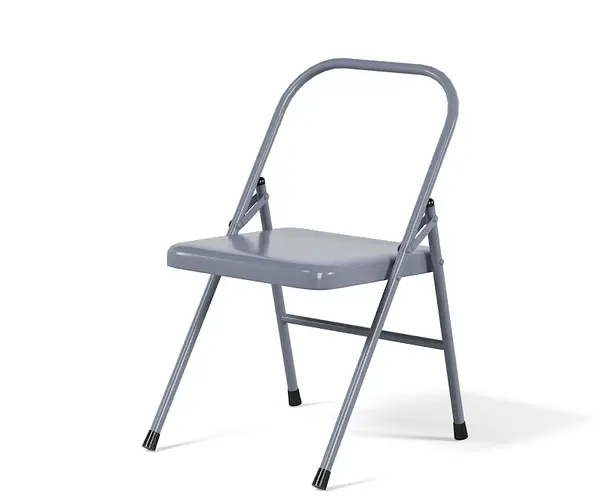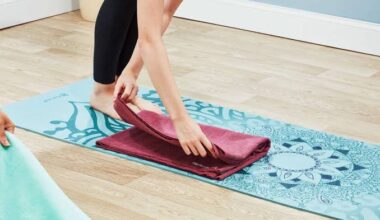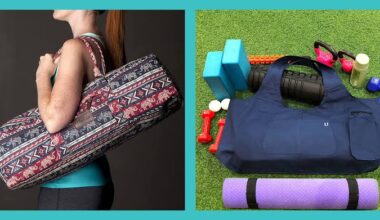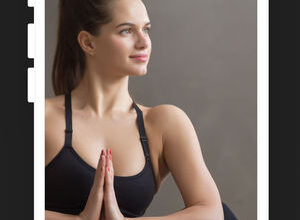Table of Contents Show
So what are yoga chairs? Yoga has always been about finding balance, both physically and mentally. But what if there were a prop that could help you deepen your practice and make challenging poses more accessible?
Enter yoga chairs, a versatile and innovative addition to your yoga toolkit. You may not be familiar with yoga chairs and their use. So, let’s explore what yoga chairs are, how they can enhance your practice, and why you should consider adding them to your yoga routine.
Disclosure: As an Amazon Associate I earn from qualifying purchases.

What Are Yoga Chairs?
A yoga chair is a flexible yoga tool for diverse postures. It is robust, offering excellent support for various yoga asanas. A yoga chair costs between $50 to $200.
A yoga chair typically consists of a sturdy wooden or metal frame with a padded or non-padded seat. The unique design of these chairs allows for a wide range of applications in yoga practice, from asana (physical postures) to pranayama (breath control) and meditation.
How Can Yoga Chairs Benefit Your Practice?
- Improved Alignment: Yoga chairs provide excellent support for achieving correct alignment in poses. They can assist in deepening stretches, opening the chest, and aligning the spine. This is particularly helpful for practitioners working on challenging poses like shoulder stands, headstands, or backbends.
- Increased Stability: Balancing poses can be challenging, especially for beginners. Yoga chairs offer a stable base, helping you build confidence in poses that require balance and coordination.
- Enhanced Flexibility: Using a yoga chair allows you to gradually work on increasing your flexibility. You can use the chair to support your weight in stretches, gradually reducing the need for external support as your flexibility improves.
- Accessible Inversions: Inversions are a key component of yoga, known for their numerous health benefits. Yoga chairs provide a safe and accessible way to practice inversions like Sirsasana (headstand) and Sarvangasana (shoulder stand) for those who may have limitations or fear of full inversions.
- Relaxation and Meditation: Yoga chairs can be used as comfortable seats for meditation and pranayama practice. The supportive structure encourages an upright posture, making it easier to focus on breath and inner awareness.
- Back Pain Relief: For individuals dealing with back pain or discomfort, yoga chairs can offer relief by providing support and alignment during poses that target the back and spine.
You may also like Cork Yoga Blocks: Elevate Your Practice with Sustainable Support
Why Should You Consider Adding Yoga Chairs to Your Practice?
- Versatility: Yoga chairs are incredibly versatile and can be used in a variety of ways to enhance your practice. Whether you’re a beginner or an experienced yogi, there’s a place for yoga chairs in your routine.
- Safety: They provide an added layer of safety, especially when attempting challenging poses or inversions. The support they offer can prevent injuries and build confidence.
- Progression: Yoga chairs can assist you in progressing towards more advanced poses gradually. As you gain strength and flexibility, you can rely less on the chair, helping you achieve your yoga goals.
- Comfort: They make your practice more comfortable, allowing you to enjoy poses and meditation without discomfort or strain.
- Accessibility: Yoga chairs make yoga accessible to a broader range of individuals, including those with physical limitations or injuries.
- Variety: Adding props like yoga chairs to your practice can add variety and excitement, preventing boredom and keeping your yoga routine fresh and engaging.
Yoga chairs are a valuable addition to your yoga practice. They offer numerous benefits, from improved alignment and stability to enhanced flexibility and accessibility.
Whether you are a beginner looking to build confidence or an experienced yogi seeking new challenges, yoga chairs can elevate your practice to new heights. After mastering the use of yoga chairs in your practice, you may be ready to study to become a yoga instructor. You can find affordable yoga teacher training Bali courses taught by yoga experts to become a qualified instructor.
Conclusion
So, the next time you unroll your yoga mat, consider adding a yoga chair to your setup and experience the transformative power of this versatile prop. Your body and mind will thank you for it.
Frequently Asked Questions About Yoga Chairs
1. What is a yoga chair?
A yoga chair is a specialized piece of equipment designed to support and enhance yoga practice. Unlike regular chairs, yoga chairs are crafted with specific features to aid various yoga poses and stretches.
2. How is a yoga chair different from a regular chair?
Yoga chairs are distinct from regular chairs as they are designed with features such as a slanted seat, backrest, and sometimes armrests. These modifications facilitate a variety of yoga poses and make them more comfortable.
3. What are the benefits of using a yoga chair?
Using a yoga chair can provide numerous benefits, including improved posture, increased flexibility, enhanced balance, and support for challenging yoga poses. It can also aid in relaxation and stress relief.
4. Can anyone use a yoga chair, or is it only for advanced practitioners?
Yoga chairs are suitable for practitioners of all levels, from beginners to advanced. They can be used to modify poses for beginners or provide additional support for those with physical limitations. Advanced practitioners often use them to deepen stretches and explore more challenging poses.
5. How do I choose the right yoga chair for my practice?
When selecting a yoga chair, consider factors such as materials, size, and design. Look for a chair that provides stability, comfort, and suits your specific yoga practice needs.
6. What yoga poses can be performed with a yoga chair?
Yoga chairs can be used for a variety of poses, including backbends, forward bends, twists, and inversions. They are versatile tools that can enhance both standing and seated poses.
7. Are yoga chairs only used in yoga studios, or can I use one at home?
Yoga chairs are suitable for both studio and home use. Many practitioners find them convenient for home practice as they can be used to supplement a regular yoga mat and provide additional support.
8. Can yoga chairs help with back pain and posture issues?
Yes, yoga chairs can be beneficial for individuals with back pain or posture concerns. The design of the chair encourages proper spinal alignment and supports the back during various yoga poses, potentially alleviating discomfort.
9. Are yoga chairs portable and easy to store?
Many yoga chairs are designed to be lightweight and portable, making them easy to move and store. Some models are even foldable, allowing for convenient storage in small spaces.
10. How do I maintain and clean my yoga chair?
Maintenance of a yoga chair typically involves regular cleaning with a mild detergent or water and a soft cloth. Check the manufacturer’s guidelines for specific care instructions, and avoid using abrasive cleaners that could damage the materials.
11. What is the point of a yoga chair?
A yoga chair, often known as a yoga prop or a chair prop, serves as a supportive tool in yoga practice. It aids in maintaining proper alignment, providing stability, and assisting individuals in performing various yoga poses with ease and comfort.
12. Are yoga chairs worth it?
Yes, yoga chairs can be worth it for individuals seeking additional support in their yoga practice. They can help improve posture, increase flexibility, and make certain poses more accessible, especially for beginners or those with physical limitations.
13. What is the difference between yoga and chair yoga?
Yoga is a holistic practice that includes physical postures, breath control, and meditation. Chair yoga is a modified form of traditional yoga that incorporates a chair for support. It is designed to make yoga accessible to individuals with limited mobility or those who prefer a seated practice.
14. Do I need a yoga chair?
While a yoga chair is not a necessity for everyone, it can be beneficial, especially for those who may need extra support. If you have mobility issues, balance concerns, or are new to yoga, a chair can enhance your practice by providing stability.
15. What can I use instead of a yoga chair?
If you don’t have a yoga chair, you can use a sturdy and stable regular chair as an alternative. However, it’s important to ensure the chair is secure and won’t slip during your practice.
16. What is another name for chair yoga?
Chair yoga is sometimes referred to as seated yoga or yoga with chairs.
17. How do you use a yoga chair?
To use a yoga chair, sit or stand near it and incorporate it into your poses. For example, it can be used for support in seated poses, balance exercises, or to assist in achieving correct alignment in various postures.
18. Is it OK to do chair yoga every day?
Yes, chair yoga can be done every day, as it is a gentle form of exercise. However, it’s always advisable to listen to your body and consult with a healthcare professional if you have any concerns or pre-existing conditions.
19. How to do chair yoga at home?
To do chair yoga at home, find a quiet space with a sturdy chair. Follow guided chair yoga routines available online or in instructional videos. Modify poses as needed and pay attention to your body’s comfort and limitations.
20. Is chair yoga difficult?
Chair yoga is generally considered accessible and suitable for various fitness levels. It can be adapted to accommodate different abilities, making it a less challenging option compared to traditional yoga.
21. What equipment do I need for chair yoga?
The primary equipment needed for chair yoga is a sturdy chair. Optionally, you may use additional props such as blocks or straps for added support and comfort.
22. Do I need a mat for chair yoga?
While a mat is not essential for chair yoga, it can provide added comfort and stability, especially if you plan to do standing poses or use the chair on a slippery surface. Use a non-slip mat for better traction.
You May Also Like: 7 Powerful Tips on How to Do Chair Yoga for Seniors: Boost Your Health Now!




